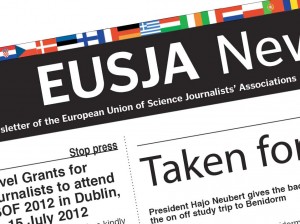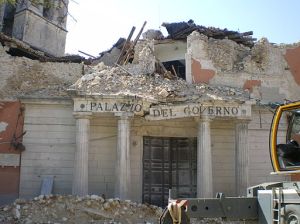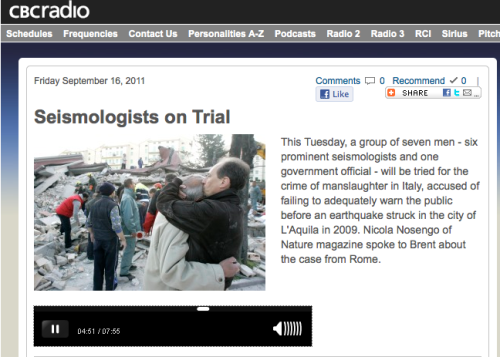 The following article by Swimmer Nicola Nosengo has just come out in the newsletter of EUSJA.
The following article by Swimmer Nicola Nosengo has just come out in the newsletter of EUSJA.
According to “Nature”, the trial that began in the Italian city of L’Aquila on September 20 will be a “watershed case”, one that will force seismologists worldwide to rethink the way they do their job, and the way science is used by policy makers. In the trial, six Italian scientists and one government official who assessed the seismic risk in the Italian region of Abruzzo before the earthquake of April 2009 are indicted for manslaughter. But the case, which will go on for a year at least, is also a test for scientific journalism, and a tough one for sure.
Getting the facts right (the first duty of a journalist) is not easy, to begin with. It is a messy story, made even more complicate by the typical Italian mix of bad politics and riddled bureaucracy. Not surprisingly, many newspapers have chosen the easy way out, describing a “trial against science” where seismologists are oddly accused of “failing to predict an earthquake”.
The accusation is surely questionable, but is actually very different. It revolves around a meeting of the Major Risks Committee, a group of consultants to the Italian Civil Protection, held in L’Aquila on March 31, 2009, one week before the devastating earthquake which hit the city on April 6, killing 309 people. The population in L’Aquila was very alarmed at the time, after four months of continuous seismic activity, and the six scientists were asked to assess the probability of a major shock and its possible impact. The outcome of a meeting was a press conference where a Civil Protection official, who had chaired the meeting, said more or less that the seismic activity in L’Aquila was “certainly normal” and posed “no danger”, adding that “the scientific community continues to assure me that, to the contrary, it’s a favorable situation because of the continuous discharge of energy”.
 Now comes the messiest part of the story. The public prosecutor of L’Aquila contends that some of the victims (32 of them) were so afraid at the time that they were about to leave their homes, or at least sleep in their cars to reduce the danger, but changed their mind after hearing that press conference. The prosecutor does not accuse the scientists of a wrong prediction. But he notes that those statements about the “discharge of energy” have been criticized by most seismologists as scientifically unfounded (matter of fact, they do not appear in the minutes of the meeting). The accusation, in other words, is to have misinformed the public with an exceedingly reassuring (and unscientific) message, thus leading some people to abandon precautions which may have saved their life.
Now comes the messiest part of the story. The public prosecutor of L’Aquila contends that some of the victims (32 of them) were so afraid at the time that they were about to leave their homes, or at least sleep in their cars to reduce the danger, but changed their mind after hearing that press conference. The prosecutor does not accuse the scientists of a wrong prediction. But he notes that those statements about the “discharge of energy” have been criticized by most seismologists as scientifically unfounded (matter of fact, they do not appear in the minutes of the meeting). The accusation, in other words, is to have misinformed the public with an exceedingly reassuring (and unscientific) message, thus leading some people to abandon precautions which may have saved their life.
The long paragraph above is enough to show some of the difficulties this story poses for science journalists. It takes many words to explain it, even on a basic level. When covering a science story, we are used to sacrifice most of the facts and concentrate on the few fundamental ones, skipping the details. But here the details are essential (as it usually happens in criminal trials,) and leaving even one element out of the story (the meeting, the press conference, the scientific consensus on seismic swarms, what the victims did and what their relatives say they were going to do, the timing of it all) results in distorting it. Also, this story forces the reporter to combine and master very different languages. On one side there is seismology (a scientific discipline where uncertainty reigns), on the other there is criminal law. Even when the two disciplines use the same words, they are often meaning very different things.
Not surprisingly, some scientific media have chosen a partisan approach, acknowledging that the accusation is less absurd than it may seem (in other words, that it is not about earthquake prediction) but taking side with the scientists: it is the case of New Scientist, for example, which published a long commentary by Thomas Jordan, a highly respected American seismologist who will testify in favour of the defendants. Others, notably Nature, have taken a more nuanced position, reporting extensively on the view from L’Aquila, particularly from the victims’ relatives, and stressing that scientists have lessons to learn from the case.
Strangely enough, the case has raised much more interest abroad than in Italy, where national media have hitherto paid little attention to it. That is a shame, mostly because no one is questioning the role played by those very media in the case, and what media professionals, in Italy as elsewhere, could learn from it. The media are not at the bar (and rightly so). But it was the media that conveyed the messages, right or wrong, which are now at the center of the trial. TV stations edited and broadcasted those reassuring statements. Local papers reported about the press conference. Many of them were giving space and resonance to the so-called “predictions” by Gioacchino Giuliani (an amateur seismologist who alarmed the population by announcing a strong earthquake in the region, though in a different area), which played a big part in complicating the work of the committee.
At the trial, one of the scientists’ lawyers has explicitly accused the mass media of distorting the scientific message of the meeting, implying they, and not the scientists, are responsible for what happened. She is largely wrong. The media have their own logic, and it is the work of public officials and risk communication experts to learn how to work with them in order to get the right message to the population. Still it would be a waste if journalism, in Italy as elsewhere, did not use this chance to reflect on its role in risk communication.




